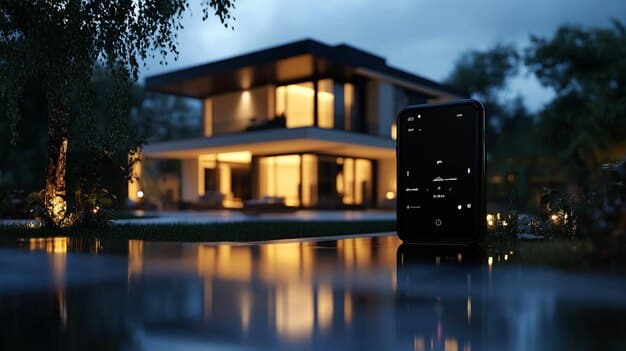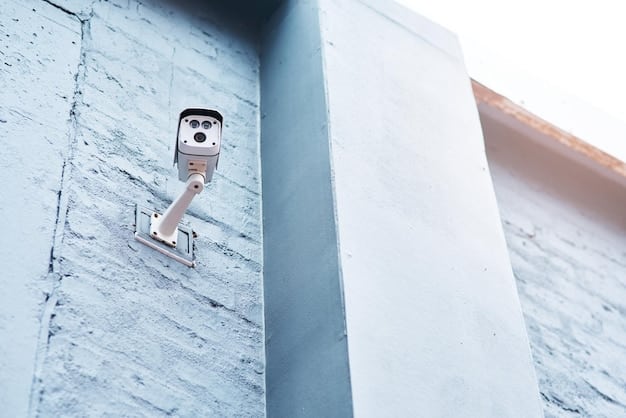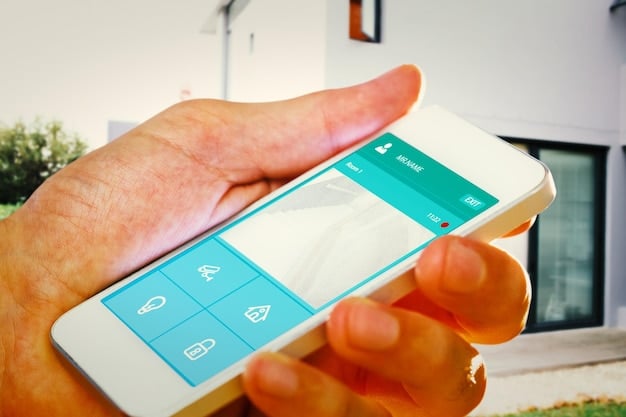Smart Home Security Showdown: Top 5 DIY Systems for US Homes in 2025

In 2025, securing your US home with a DIY system offers flexibility and control; this article compares the top five smart home security systems, highlighting their features, pros, cons, and suitability for different homeowner needs.
Protecting your home and family is a top priority. The **Smart Home Security Showdown: Comparing the Top 5 DIY Systems for US Homeowners in 2025** reveals the best do-it-yourself security solutions available, empowering you to make an informed decision.
Top DIY Smart Home Security Systems for US Homes in 2025
Choosing a DIY smart home security system can feel overwhelming with so many options available. We’ve narrowed it down to the top contenders for 2025, focusing on ease of use, features, and value for money.
Factors to Consider When Choosing a System
Before diving into specific systems, it’s important to consider your individual needs. Think about the size of your home, your budget, and the level of security you require.
Also, consider whether you prefer professional monitoring or self-monitoring and if integrating with existing smart home devices is important.
- Coverage Area: Determine the square footage and number of entry points you need to protect.
- Budget: Set a realistic budget, including upfront equipment costs and potential monthly fees.
- Integration: Consider compatibility with other smart home devices like smart lights and voice assistants.
Understanding these factors will help you choose the system that best fits your specific circumstances.
When thinking about DIY smart home security systems, understanding your particular needs is the most important first step. From there, it’s helpful to compare different systems in a structured way.
Ring Alarm: A Comprehensive and Popular Choice
Ring Alarm is a well-known and popular DIY security system that integrates seamlessly with Ring’s wide range of security cameras and video doorbells, giving you a complete security ecosystem. It’s a solid choice for many homeowners.
Key Features of Ring Alarm
Ring Alarm offers a variety of features, including door and window sensors, motion detectors, and a base station with a built-in siren. The system can be self-monitored or professionally monitored with a Ring Protect plan.
Pros and Cons
Ring Alarm’s strengths lie in its ease of use, affordability, and integration with other Ring devices. However, it’s important to also consider any potential drawbacks.
- Pros: Affordable, easy to install, integrates with Ring cameras and doorbells.
- Cons: Camera privacy concerns, limited smart home integration compared to some competitors.
- Consider adding extra sensors based on your home’s layout.
Ring Alarm is a good all-around choice if you’re already invested in the Ring ecosystem or are looking for an affordable and easy-to-use system.

SimpliSafe: Simple Setup, Robust Security
SimpliSafe is another popular DIY security system known for its straightforward setup and comprehensive protection. It’s a good option for those who prioritize simplicity and reliability.
SimpliSafe offers customizable packages to fit various home sizes and security needs.
The modular design allows homeowners to add or remove sensors and devices as required.
Let’s examine some of the system’s features:
SimpliSafe System Features
SimpliSafe differentiates itself through its easy installation and user-friendly features. Let’s delve into some of its aspects.
- Easy Installation: Sensors and base station can be set up in minutes.
- Professional Monitoring Options: Provides 24/7 professional monitoring for around-the-clock security.
- No Contracts: SimpliSafe offers no long-term contracts, so you can cancel their monitoring service anytime.
Weighing the pros and cons can help you decide whether a system is the right fit.
Pros and Cons of SimpliSafe
Let’s explore some of the advantages and disadvantages associated with SimpliSafe.
- Pros: Easy to set up, reliable performance, no contracts.
- Cons: Limited smart home integration, basic app interface.
- It doesn’t integrate with other smart home devices due to limited support.
For those that value keeping things simple, SimpliSafe is an easy-to-manage system that’s also effective.
Abode: Advanced Customization and Flexibility
Abode stands out with its advanced customization options and flexibility. It caters to users who want more control over their security system and want to integrate it closely with other smart home devices.
Customization and Integration
Abode offers a wide range of compatible devices and integrates with platforms like Apple HomeKit, Google Assistant, and Amazon Alexa. This allows for extensive customization and automation options.
The system is designed to adapt to the evolving needs of your smart home.
Advanced users can create custom rules and scenarios for enhanced automation and security.
Why Abode Might Be Right for You
Let’s explore the features that could make this your system of choice.
- Advanced integration capability with HomeKit, Google Assistant, and Alexa.
- Customizable security automations and rules.
- Highly flexible in terms of integrating various smart home devices.
Abode requires more technical experience to set up than some other DIY security systems.

Arlo Pro: Wireless Freedom and High-Quality Cameras
Arlo Pro focuses on wireless security cameras, offering a lot of flexibility in placement and ease of installation. The cameras offer high-resolution video and advanced features like motion detection and two-way audio.
Arlo Pro Features
One of the primary features of the Arlo pro is that it offers a number of integrations. Let’s examine this a bit further.
- Completely Wire-Free: Cameras operate on batteries and connect wirelessly to a base station.
- High-Resolution Video: Captures a detailed video that allows the user to clearly see and record activities.
- Integration: Can integrate with Amazon Alexa, Google Assistant, and IFTTT.
The Arlo Camera is easy to install, with wireless, quick setup options.
Cameras can be placed anywhere, no wiring needed.
Pros and Cons
As with any security system, it is worthwhile to explore the benefits and drawbacks.
- Pros: Wireless, high-quality video, easy installation.
- Cons: Battery life dependent on usage, subscription required for cloud storage.
- Be sure to consider the cost of extra batteries or subscription plans.
The camera battery might require frequent replacement, depending on how you use it.
Nest Secure (Google Nest): Seamless Smart Home Integration (Discontinued, but Still in Use)
Although Google Nest Secure has been discontinued, many users still rely on it for home security because of its seamless integration with the Google ecosystem. While support may eventually wane, it’s worth considering for its smart home capabilities.
Key Nest Secure Features
For those still using the Nest Secure, here are some of the reasons to continue using it until a replacement becomes necessary.
- Tight Integration: Works seamlessly with Google Assistant and other Nest devices.
- User-Friendly App: The Nest app provides easy control and monitoring.
- Although a great system, it is no longer available for purchase.
Considerations for Existing Users
Many users feel that it is still a worthwhile product. However, there are potential disadvantages to consider.
- Cons: No longer available for purchase, future support uncertain.
- It may be more difficult to find replacement parts and ongoing support.
- Users may want to start researching replacement options for Nest Secure.
Existing Nest Secure users will likely need to transition to a new system in the future, so it’s an important factor to keep in mind.
| Key Point | Brief Description |
|---|---|
| 🛡️ Ring Alarm | Affordable, integrates well with Ring devices. |
| 🛠️ SimpliSafe | Easy setup, no contracts required. |
| 💡 Abode | Advanced, works with HomeKit, Alexa, and Google Assistant. |
| 📸 Arlo Pro | Wireless, superb video resolution quality. |
Frequently Asked Questions
A DIY (Do-It-Yourself) home security system is a security setup you install and manage yourself, as opposed to professional installation and monitoring. They are a convenient and lower cost solution for protecting your home.
Yes, DIY security systems can be very effective. They offer a visual deterrent and alert you to potential threats. Their effectiveness is enhanced if paired with prompt response from authorities or monitoring services.
Many systems have cellular backup, so they can still function during outages. Some record locally, ensuring that data is logged, regardless of whether the internet is active during events.
Yes, many DIY security systems are compatible with smart locks, allowing you to remotely lock or unlock your doors. This integration enhances security and provides convenient access control. Check the manufacturer’s supported device list.
Assess your needs, consider your budget, and evaluate the system’s features and compatibility with other smart home devices. Reading reviews and comparing systems side-by-side can also help you make an informed decision.
Conclusion
In conclusion, choosing the right DIY smart home security system depends on your individual needs and preferences. Whether you prioritize ease of use, advanced customization, or video quality, there’s a system that can help you protect your home and family in 2025.





